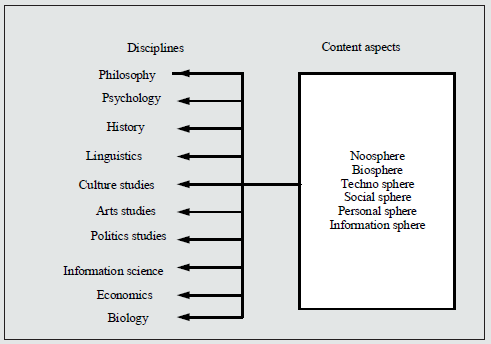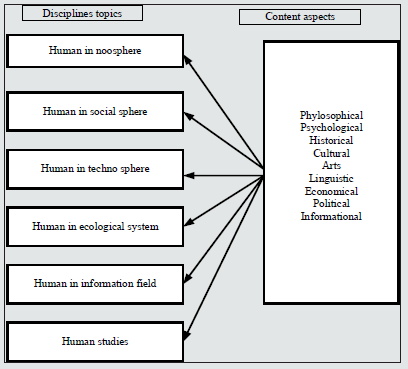
Lupine Publishers Group
Lupine Publishers
Menu
ISSN: 2690-5752
Review Article(ISSN: 2690-5752) 
Anthropology Approach in Educational Sciences Volume 4 - Issue 2
Veronika Pisarenko*
- Foreign Languages Department, Southern Federal University, Taganrog, Russia
Received:May 25, 2021; Published: June 09, 2021
Corresponding author:Veronika Pisarenko, Foreign Languages Department, Southern Federal University, Taganrog, Russia
DOI: 10.32474/JAAS.2021.04.000185
Abstract
This paper examines the role of the anthropological approach in education sciences. It is shown that a person is the object of research in many modern sciences, but none of them can give a complete and complete picture of a person. In this regard, interdisciplinary research is needed, the results of which are used to create and implement educational systems. The paper considers the features of human development from the standpoint of the anthropological approach.
Keywords:Anthropological Approach; Education, Synergetic Approach; Interdisciplinary Research; Human being
Introduction
Anthropological knowledge is represented by a wide variety of sciences. The information accumulated in this area to date is enormous, but it not only does not reduce the number of issues related to penetration into the essence of human nature but increases their number. Man is so diverse that different sciences find space for search and research in him. “In the library of human reflection, there is no single, unified volume that conveys ultimate understanding. Instead, we have written many nested stories that probe different domains of human inquiry and experience: stories, that is, that parse the patterns of reality using different grammars and vocabularies” [1]. If for the economy a person is a rational thinking creature, then for psychology he is an irrational being in many respects. History considers him as the author of certain historical events. Man is interesting to sociology as a creature with many options for behaviour. For genetics, a person is a creature that has largely programmed behaviour. For cybernetics, a person is a universal robot, and for chemistry, a person is a set of certain chemical compounds [2]. As a result of this multidimensional research, inherent in different areas of modern human studies, there is a variety of definitions of the concept of “human being”. Some of them directly confront each other, others converge, convert with each other. At the same time, “man” is used to designate all inhabitants of the Earth of the species Homo sapiens and to designate a separate representative of this species [3]. Modern anthropological knowledge is characterized by the recognition that man is an inexhaustible, mysterious subject of knowledge [4]. A complete comprehension of its essence is, in principle, impossible. Analysis of human nature shows that he is truly mysterious and inexhaustible for scientific research. F.M. Dostoevsky wrote: “Man is a mystery. It must be solved. And if you are going to solve it all your life, then do not say that you have lost time, I am engaged in this mystery, because I want to be a man”[5].
As a living being (individual, organism), man is an integral part of the biosphere, flora and fauna of the Earth, belongs to the Cosmos. Human society is not a mechanical addition of separate individuals, but the integration of people into each other, when an individual (generations of people are both materially and ideally represented in other people, takes part in their activities and communication, contributes to their semantic sphere, to being, supports their values, ideals, beliefs, attitudes. One example of such integration is education as a field of activity. One of the main methodological approaches [6-8] in educational activities is the anthropological approach, which is widely used in modern education sciences. The anthropological approach suggests the following groups of human development factors: biological, socio-cultural and anthropological. Biological factors include the activity of the Sun, the human genome and the natural characteristics of human life. The socio-cultural factors include purely human needs and the human way of life. The anthropological factor of human development is specific human activity: objective, mental, emotional. It is obvious that biological, culturological and anthropological factors are interrelated and mutually determine each other. For example, a specific human activity is based on his innate genetic characteristics but cannot operate outside of culture and social relations. In accordance with the anthropological approach, the following properties of human development are attributed to the characteristic features of human development: integrity, inconsistency, nefrontality, heterochromism, disequilibrium, reversibility. Integrity lies in the fact that individual development of a person and the development of a species represent a complex change in appearance, physiological processes, lifestyle, occupation, psychological functions, behavior, and the spiritual world. Any changes accompanying human development do not exist separately from each other, are related and define each other. All factors and conditions of human development do not act in parallel, but in a complex mutual connection with each other. The contradictory nature of development lies in the fact that man and humanity change all the time and at the same time remain identical with themselves. Human development includes processes of two types: the simultaneous complex implementation of initial capabilities and abilities and the acquisition of fundamentally new properties. Modern science is more and more inclined towards the idea that development is a dialectical contradictory unity of regressive and progressive transformations.
Non-frontality of development (the term proposed by A.A. Bodalev) is manifested in the fact that the rates of biological, psychological, social development of a person do not coincide with each other. For example, it is known that different peoples and tribes currently inhabiting the Earth, despite the information revolution, globalization and other processes, are at fundamentally different stages of development: some live in the Stone Age, others in the Middle Ages, and others in the post-industrial world. There is another aspect - the rate of change in different structures of any person is not the same. A person’s attainment of a high level of physiological maturity does not occur simultaneously with the attainment of intellectual, volitional, and social maturity. The nonfrontality of development in adolescence is especially evident, when different systems of the body grow and change at different rates: vascular, bone, nervous, muscular, which makes this period quite difficult. Heterochronism is an uneven distribution over time of changes occurring in phylogeny and ontogeny. The fact of heterochronism is confirmed by the fact that the periods of age development traditionally distinguished by science are periods of life that are different in the number of years. The following fact speaks about the heterochronism of human development: the transition from childhood to youth, from youth to maturity occurs in each culture in the same calendar dates (each culture has its own), and the transition to old age of representatives of the same culture is very individualized.
The disequilibrium of human development is revealed in the fact that phylogeny and ontogeny are non-monotonic processes. On the contrary, in each of them both calm periods and leaps, “explosions” are found. Here, using the synergistic approach [7], we can talk about bifurcation zones and attractors, which are various life events. Reversibility lies in the fact that movement is possible both in the direction of humanization and in the direction of dehumanization. This is evidenced by numerous studies of children who are brought up in conditions unusual for a child. The listed characteristic features of human development, which the anthropological approach proposes to education sciences, are the starting points for the design of modern educational systems. If we put the human dimension as the basis for innovation in education, then, provided that the above requirements are met, the following scheme for implementing the integral approach within the framework of the concept of interdisciplinarity, shown in Figure 1. It is difficult to imagine that any of these schemes - concepts can be implemented in its pure form in a short time. It is difficult due to the lack of adequate teachers having high levels of all these competences. For these reasons, in all universities, the process develops on the basis of opportunities, and not along the way of implementing one or another rigid innovative scheme or concept (Figure 2).
Figure 2: Scheme for the implementation of an integrated approach within the framework of an interdisciplinary concept.

Conclusion
The only correct approach would be to gently adjust the process from multiple disciplines to interdisciplinarity. At this stage, it is desirable to have as large a set of humanitarian and natural science courses as possible, which students could master at their own choice, as is actually done in all Western educational institutions. With this approach, firstly, it turns out what students can perceive and what not, and secondly, teachers who want to improve have time to accumulate primary experience and understand both each other and related disciplines, after which it is possible to form a general axiomatics and determine a specific number of compulsory and optional disciplines. Thus, the anthropological approach is one of the main in modern educational sciences. It creates the basis for the study of a person in the interdisciplinary field of modern science and allows you to build the educational process in accordance with the characteristics of a person.
References
- Dostoevsky F, Leningrad (1985) Full composition of writings in 30 volumes. 28: 60-63.
- Greene Brian (2020) Until the End of Time: Mind, Matter, and Our Search for Meaning in an Evolving Universe. First edition, Alfred A. Knopf Books, New York, USA 2020.
- Kureychik V, Pisarenko V (2017) Modeling of High School Educational Environment Based on Synergetic Approach Synergetic Ideas in Pedagogical Modeling. Proceedings of the IV International Research Conference. Information Technologies in Science, Management. Social Sphere and Medicine (ITSMSSM 2017).
- Mainzer K (2004) Thinking in Complexity. The Computational Dynamics of Matter, Mind, and Mankind. Fourth Revised and Enlarged Edition. Springer-Verlag Berlin Heidelberg.
- Niyazbaeva NN (2018) Existential Antropology as the Antropology of Education. Discourse 20: 133-139.
- Pisarenko Veronika, Kureychik Victor (2018) Synergetic Principles in Formation of The Future Specialist Professional Culture.
- Razy Élodie (2018) Practising Ethics: From General Antropology to the Antropology of Childhood and Back Again. Anthropo Chindren.
- Solodova EA (2013) New models in the education system: A synergetic approach: A textbook. Foreword by GG Malinetsky 56(15): 300-323.

Top Editors
-

Mark E Smith
Bio chemistry
University of Texas Medical Branch, USA -

Lawrence A Presley
Department of Criminal Justice
Liberty University, USA -

Thomas W Miller
Department of Psychiatry
University of Kentucky, USA -

Gjumrakch Aliev
Department of Medicine
Gally International Biomedical Research & Consulting LLC, USA -

Christopher Bryant
Department of Urbanisation and Agricultural
Montreal university, USA -

Robert William Frare
Oral & Maxillofacial Pathology
New York University, USA -

Rudolph Modesto Navari
Gastroenterology and Hepatology
University of Alabama, UK -

Andrew Hague
Department of Medicine
Universities of Bradford, UK -

George Gregory Buttigieg
Maltese College of Obstetrics and Gynaecology, Europe -

Chen-Hsiung Yeh
Oncology
Circulogene Theranostics, England -
.png)
Emilio Bucio-Carrillo
Radiation Chemistry
National University of Mexico, USA -
.jpg)
Casey J Grenier
Analytical Chemistry
Wentworth Institute of Technology, USA -
Hany Atalah
Minimally Invasive Surgery
Mercer University school of Medicine, USA -

Abu-Hussein Muhamad
Pediatric Dentistry
University of Athens , Greece

The annual scholar awards from Lupine Publishers honor a selected number Read More...





